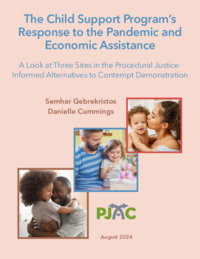The Child Support Program’s Response to the Pandemic and Economic Assistance
A Look at Three Sites in the Procedural Justice-Informed Alternatives to Contempt Demonstration

When a child does not live with both parents, the parent who does not live with the child, called the noncustodial parent, may be responsible for a share of the costs associated with raising the child. Child support agencies help families obtain this support by locating parents, establishing paternity, setting financial obligations, and enforcing those obligations, aiming to secure payments from noncustodial parents to support the well-being of their children.
The COVID-19 pandemic began during the Procedural Justice-Informed Alternatives to Contempt (PJAC) demonstration project, which tested a new approach to child support service delivery. The PJAC demonstration project integrated principles of procedural justice (the idea of fairness in processes) into enforcement practices in six child support agencies across the United States. This report uses data collected during the public health emergency to examine how three child support agencies experienced the COVID-19 pandemic. It focuses on how employment, earnings, and unemployment insurance patterns changed for members of the PJAC sample after the onset of the pandemic.
Findings include:
- Noncustodial parents faced employment challenges during the pandemic but received unemployment benefits and federal pandemic economic assistance. Child support agencies withheld and intercepted some benefits and directed them toward parents’ child support obligations (as is standard practice with tax refunds and unemployment insurance), which contributed to increased child support payments. Yet noncustodial parents did not, on average, reduce their child support debt. Their steady debt levels, even during a period of high collections, reveal how difficult it can be for parents to pay down child support debt, possibly due in part to policies such as high interest rates on that debt and high order amounts that noncustodial parents who earn low incomes may find it difficult to pay in full.
- The pandemic underscored the tension between the dual goals of the public child support program: supporting families and recovering the government’s costs when custodial parents receive public assistance to help support their children. While pandemic benefits were intended to help parents replace lost earnings, child support interception and withholding policies meant that those funds were sometimes directed toward the government rather than families. Child support agencies had limited ability to change collection policies in response to the pandemic and pandemic benefits, but, when possible, they made it a priority to direct funds to families. For example, an executive order in California required stimulus interceptions to go toward child support debts owed to custodial parents before debts owed to the state.
- Pandemic benefits highlighted the need for child support programs to improve systems meant to capture employment information and collect payments. The systems child support programs use to capture that information typically do not reflect independent employment or gig work. During the pandemic, people were able to receive unemployment insurance for that sort of work, and staff members reported that pandemic unemployment benefit withholding produced payments on cases with very few to no past payments or no record of past employment. This pattern points toward a reality that child support staff members have long suspected: The existing automated systems used to withhold child support payments may not be entirely effective. As independent work has become more common, child support programs will face an increasing need to develop new approaches to collect support from independent workers.






